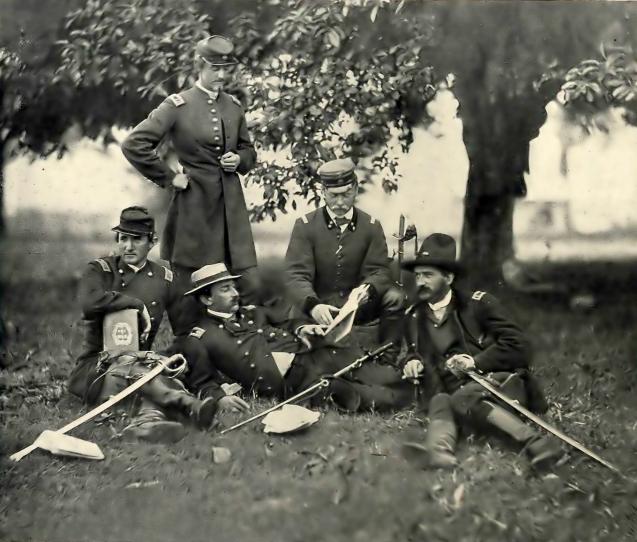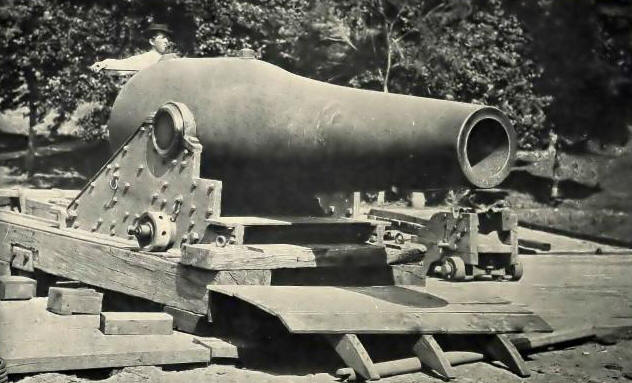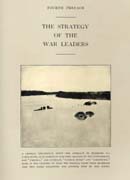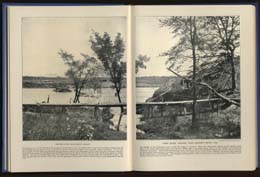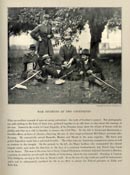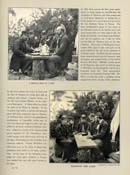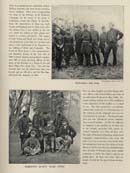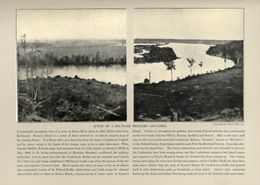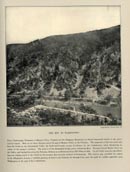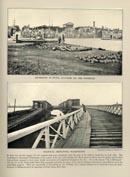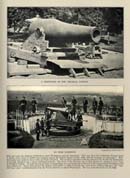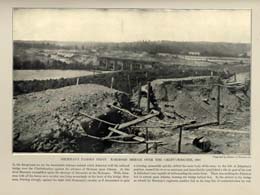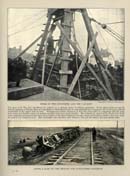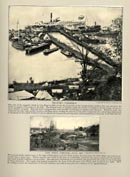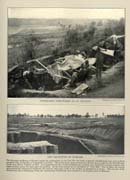Civil War Strategy and Tactics
![]()
This Site:
THE STRATEGY OF THE CIVIL WARBy EBEN SWIFT Lieutenant-Colonel 8th Cavalry, United States Army [Back to Civil War Pictures]
*Stonewall Jackson and the Civil War, Lieutenant-Colonel G. F. R. Henderson, C.B.
"Strategy" is a comparatively recent addition to our language. It is derived from a Greek word, meaning generalship, and has several valuable derivatives, as "strategic" and "strategist," which make it a more useful word than generalship. It means the art of the general and indicates the time, place, and way to fight battles. The War of the States was viewed at first with indifference by foreign military men. For many years past, however, it has claimed their close attention, because they have come to realize that new conditions were tested then, and that new influences, which changed the art of the general even from the respected models of Napoleon fifty years before, were at work. Ironclads, entrenchments, railroads, the breech-loader, a new kind of cavalry were the fresh factors in the problem. Although hostilities at first began over an area half as large as Europe, the region of decisive operations was, on account of lack of communication, narrowed to the country between the Atlantic and the Mississippi, about seven hundred miles in an air-line. The line was unequally divided by the towering barrier of the Alleghany Mountains, about two hundred miles wide, over which communication was difficult. The eastern section of the country beyond the range was about one hundred miles wide and the western section was about four hundred miles wide. In Maryland, northwestern Virginia, Kentucky, and Missouri sentiment was divided between the Union and the Confederacy. The Mississippi River separated three of the seceding States from the remaining eight. The immense amount of supplies needed for a great army caused military operations on a large scale to be confined to rail and water lines. Of the former, both the North and South had several routes running east and west for lateral communication, and the South had several running north and south in each section, which could be used for lines of military operations. In respect to water routes, the North soon demonstrated its complete control of the sea and was thus able to choose its points of attack, while interior water routes were available by the Mississippi, Tennessee, Cumberland, and James rivers. The advantage of the water route over that by rail was at once utilized by the Northern generals. It was not so vulnerable to attack as the railroad. All navigable rivers within the area of operations were used for this purpose, and McClellan, Burnside, and Grant used the Chesapeake Bay and its tributaries to carry their base of supplies close to Richmond. The operations of the Confederates, on the other hand, were greatly restricted by being confined to railroad lines. Several natural features which were certain to influence events to a great extent are to be noticed. In Virginia, numerous rivers, perpendicular to the direct line of advance, form good lines for defense and also obstacles to an advance. Several mountain valleys leading north at the eastern ranges of the Alleghanies gave opportunities for leading large forces safely into Pennsylvania from Virginia, or vice versa. Within the mountain district, a railroad from Lynchburg, Virginia, to Chattanooga, in Tennessee, about four hundred miles long, gave an opportunity for transferring troops from one section to the other, while the corresponding distance at the North was three times as great. In the western section, the Tennessee and Cumberland rivers are separated at one place by a narrow neck about two miles wide, thus somewhat simplifying the problem of controlling these two important streams. The strategic chess-board, then, gave great opportunities to skilful generalship. The Virginia rivers gave strength to long defensive lines, screened marches from east to west, and forced the Northern generals to seek the flank rather than the front attack. The Shenandoah valley afforded a safe approach to Washington from the rear. This was availed of by Lee, Jackson, and Early to keep many thousand men of the army of the North in idleness. In the West, the long line defended by scattered troops was weak at every point and was quite easily broken by Grant, particularly when the South was slow in grasping the situation there. The advantage of the Richmond-Chattanooga railroad was not used by the Confederates until too late for success. Thousands of Union Troops were "Pinned Down" in the Defense of WashingtonThe strategy, on account of political and other influences, was not always chosen according to the best military principles. Such influences always exist, and it is the duty of the soldier to conform and to make his plan to suit as best he can. Under the head of policy would come Lee's several invasions of the North, undertaken with insufficient forces and too far from his base of supplies. Numerous causes have been given for these campaigns, the most plausible of which were of a political and not of a strategic nature. It was thought that a victory won on Northern soil might lead to intervention on the part of foreign nations, or that it would increase the disaffected element in the North to such an extent that the South could dictate a peace. The policy of making military operations conform to the desire to help Northern sympathizers in eastern Tennessee had a powerful influence on the entire war. In the spring of 1862, it would have taken Buell into eastern Tennessee, instead of to the assistance of Grant and would have changed the course of events in the Mississippi valley. Three months later, it was one of the potent influences that led to the breaking up of Halleek's army at Corinth. It finally caused Buell's relief from command because of his disapproval. It caused Burnside's army to be absent from the battle of Chickamauga. In 1864, the campaigns of Price in Missouri and Hood in Tennessee are said to have been intended to affect the presidential election at the North by giving encouragement to the party which was claiming that the war was a Federal failure. If that was not the case might not Hood have done better by marching in the track of Longstreet through Knoxville, Tennessee, and Lynchburg, Virginia, to join Lee, while Sherman was marching to the sea, entirely out of reach? An unreasonable importance, from a military point of view, was given to the capital of each government. The capital of the United States had been captured in two wars without producing more than local effect, but every plan in Virginia was contingent upon the safety of Washington, thus causing the diversion of many thousand soldiers for that single duty. On the Southern side the correct military decision would have been to abandon Richmond as soon as Petersburg was invested, but the Government delayed, for political reasons, until it was too late, and the defending army surrendered as a consequence. In the distribution of troops the Federal authorities were hampered by the rival claims of the border States, which thought they required protection. Hence, Ohio sent an army into West Virginia; Pennsylvania, into the Shenandoah valley; the national Government concentrated troops for the protection of its capital; the Western States gathered along the Ohio River and in Missouri. This great dispersion existed on both sides and continued more or less till the end of the war. The advantage it gave was in the protection of the friendly portion of the population and in the good recruiting ground thus secured. The great difficulty of holding troops in service, whose home country had been overrun, was appreciated by both sides and exercised a strong influence on the plans of the generals. These conditions dictated much of the strategy which is subject to criticism, and should not be forgotten. The policy of furloughing great numbers of soldiers during the war, as an inducement to reenlist, was probably unavoidable, but it helped to cause inactivity during many months and in the case of Sherman's Atlanta campaign it caused the absence of two of his divisions. Absenteeism is one of the inevitable consequences of a long war, with troops untrained in time of peace by modern methods. Lincoln complained of it and the generals seemed powerless to limit or prevent it. Probably the latter are entitled to most of the blame. It was not uncommon for a general to call for reinforcements at a time when large numbers of his troops were absent. The armies were indeed long in getting over the characteristics of raw troops, but the generals in their early movements do not appear much better than the troops. Every man who had been graduated from West Point was regarded as a "trained soldier," which was a mistake, because West Point was a preparatory school, and such men as had studied the art of high command had done so by themselves. The trade of the general was new to all, and had to be learned in the hard school of experience. In four of the early campaigns in which the Federal troops were practically unopposed, they marched on an average of less than seven miles per day, while, in case of opposition by a greatly inferior force, the average was down to a mile a day, as in the Peninsula campaign and the advance on Corinth. The plans for the early battles were complicated in the extreme, perhaps due to the study of Napoleon and his perfect army opposed by poor generals. Bull Run, Wilson's Creek, Seven Pines, Glendale, Malvern Hill, Shiloh, Gaines' Mill were of this kind, and failed. Even at Gettysburg, July 2, 1863, Lee's failure to execute his echelon attacks showed that his army was not yet ready to perform such a delicate refinement of war. As an example of improvement, however, take Jackson's march of fourteen miles on a country road and the battle fought on May 2, 1863, all between daylight and dark of one day. In battles, also, we notice the fine play of early campaigns replaced by a savage directness and simplicity at a later period, in the Wilderness by Lee and at Spottsylvania by Grant. Thus it was that both leaders had ceased to count on the inefficiency of the enemy. At the beginning of the movement on Richmond both Lee and Grant seemed reckless in the risks they took. It was not so later. The earliest form of strategy was the practice of ruse, stratagem, and surprise, but they have long been considered as clumsy expedients which are no longer effective against the best troops and commanders. Among instances which are often classed in this category are Shiloh, Chancellorsville, and the Wilderness. Some forms of strategy have not changed in several thousand years. Sherman, for instance, crossed the Chattahoochee, which was held by Johnston, in 1864, in the same way that Alexander crossed the Hydaspes in the year 326 B. C., by feinting at one flank and crossing at the other. Vicksburg CampaignThe Vicksburg campaign gave great fame to General Grant and is really one of the most complete and decisive examples in history. In this campaign, he deliberately crossed the river north of Vicksburg, marched south and crossed again below Vicksburg. Then, relying on the country for supplies, he moved to Jackson, forty-five miles east of Vicksburg, where he interposed between the fractions of the Confederate army under Pemberton and Johnston. He then turned back again toward the Mississippi, drove Pemberton into Vicksburg, established a base of supplies at the North and invested the city. In this case, it is noticeable that the tendency to rate localities at too high a value is shown in Pemberton's retreating to Vicksburg, which was quite certain to be surrendered, instead of joining forces with Johnston to oppose Grant in the interior. Siege of PetersburgThe same point is illustrated by the siege of Petersburg. As soon as Grant's army crossed the James and began this siege the fate of Richmond was sealed, for Grant had a great army and numerous means of extending his fortified lines until they crossed every avenue of approach to Richmond. Napoleon's Tactic: Geography as the Objective, Not the Hostile ArmyMoltke remarked that strategy was nothing more than common sense, but he acknowledged that it was often difficult to decide what was common sense and what was not. He might easily have had our Civil War in his mind. In 1861, the art of war had been greatly complicated by pedantic study, principally by officers of the French school, in attempting to reduce it to an exact science. The true lesson of Napoleon's so deep-rooted is the idea of choosing a locality as the objective of a campaign instead of a hostile army, that Rosecrans' campaign, in the summer of 1863, has gone into history as the "Campaign for Chattanooga," and it has been claimed by his admirers that the possession of that place was worth what it cost—a heavy defeat at Chickamauga. In 1864, Grant had authority to lay down a choice of objective, which he had already announced in 1862. For himself it was clearly Lee's army, and it was intended to be the same with other commands as well. General Sherman, however, was not so clear in his manner of execution as was his chief. His strategy creates a suspicion that it was designed to force Johnston to retreat and to relinquish territory. There was an idea that Johnston would not give up Dalton, which he had strongly fortified, but Sherman's heavy turning movement against his rear forced him to retreat without a battle. The same strategy continued until Atlanta was reached, and still Johnston's army was undefeated, while Sherman had weakened his army by guarding a long line of communication. Judging from this, we are disposed to suspect that Atlanta, rather than Johnston's army, was Sherman's main objective. Sherman's March to the SeaLater, the historic "March to the Sea" introduces a novel element into the question, for Sherman abandoned Hood's army as a first objective, and chose Lee's army instead. It will be remembered that Sherman had difficulty in getting consent from Grant, who wanted him to ruin Hood's army first. As it turned out, Sherman marched one thousand miles and was several hundred miles from Lee at the end of the campaign. If Lee's army had been his real objective there were other ways of reaching it: first, by sending his army by sea north from Savannah, as was suggested by Grant, which would have taken two months, say until the end of February, 1865; second, by sending the troops by rail, as Schofield was moved with fifteen thousand men and as Hooker was moved with twenty-three thousand men, and, third, by marching on Lynchburg by the Knoxville road, which would have been about one-third to one-half the distance actually marched. Grant's Strategy: Destroy the EnemyLooking upon the war with all the advantage of today, it is not difficult to assume that the hopes of both sides rested on two great armies, one in the East and one in the West, and the destruction of either meant the destruction of the other. This clear estimate seems to have come quite naturally and easily to only one man during the war, and that man was Grant. Such a conception clears away a mass of secondary objectives, such as so-called "strategic points" along the coast and west of the Mississippi, which consumed hundreds of thousands of troops and had only a minor effect on the final issue. It must be admitted that Grant used some seventy-five thousand men on secondary objectives which were not successful, in 1864, when these men would have had a great effect either with the armies of Sherman or himself. He probably thought that an army of one hundred and twenty thousand men was large enough for his purposes, but he found it was a mistake. Equally fallacious with the importance given to "strategic points" was that ascribed to the occupation of territory. The control of Kentucky and Tennessee was given by Grant's Fort Donelson campaign, but the injury inflicted on the Confederate army by the large capture of men at Donelson and Island Number 10 was the real and vital result. The control of territory that was not accompanied by the defeat of the foe often had many disadvantages. Such was the experience of Grant and Sherman, the former in his first advance on Vicksburg, and the latter in the Atlanta campaign. Confederate Strategy: Weaken the Opponents Will and Try to Get Europe to Enter the WarFor the South it was an easier task to decide upon an objective because it was the weaker side and its acts were determined by those of the stronger. The main idea of the strategy of the Southern generals was to divert attention to side issues, to induce the opposing general to weaken his forces at decisive points. Numerous examples of diversions are afforded by Jackson's Valley campaign, in 1862, which kept many thousand men away from McClellan; Early's march on Washington, and many cavalry raids. The result of a study of objectives shows that, with good troops, and safe, but not brilliant, generals on both sides, the only way to overthrow the opponent is to attack and defeat his main army. The long periods of inactivity in the several armies of the North seem to have been largely, but not always, due to the frequent change of commanders. The other causes would take long to analyze. Lee made six campaigns in fourteen months, from May, 1862, to July, 1863, a performance unequaled in history. But McClellan's army was inactive for ten months after Bull Run; Rosecrans' army for five months after Murfreesboro, and Grant's army for four months after Vicksburg, while Grant's army was almost in the same class during its ten months before Petersburg. The concentration of scattered forces at decisive points, which is technically called in the text-book the use of interior lines, and in more homely phrase, "getting there first with the most men," was often skillfully performed on both a large and small scale. Thus, Johnston joined Beauregard at Bull Run in time to win the battle; Jackson alternately attacked the divided forces of his opponents and neutralized their greatly superior forces, and finally joined Lee for another campaign; Longstreet joined Bragg to win Chickamauga; Ewell joined Breckinridge to defeat Sigel. Many opportunities were lost, even in the very campaigns mentioned, as we see them today. Both Sides Failed to Fully Exploit their VictoriesThe conduct of pursuits confirms the idea that it is the most difficult operation presented to a general. Johnston after Bull Run, McClellan after Antietam, Meade after Gettysburg, Bragg after Chickamauga, Grant after Chattanooga, and Lee after Fredericksburg practically allowed the defeated enemy to escape without further injury. Lee's pursuit of McClellan in the Seven Days' Battles on the Peninsula and of Meade in the operations of October, 1863, had only partial success. Near the end of the war Thomas' pursuit of Hood, after Nashville, showed a much higher efficiency than had yet been reached, and the Appomattox campaign gives the only entirely successful instance in about one hundred years of military history. Robert E. Lee's StrategyThe campaigns of Lee and Jackson were models of their kind. Napoleon has said that the general who makes no mistakes never goes to war. The critic of Lee finds it hard to detect mistakes. No general since Hannibal, and perhaps Napoleon, in the last two years of his campaigns, has made war under greater disadvantages and accomplished so much with an inferior force. While all great generals before him inherited a ready-made army, Lee, like Washington, made his own army. He fought soldiers of the same race and generals of the same school as himself. His genius was shown in many ways, but nowhere more than in his ability to calculate chances, even when he was violating the so-called rules of war. He used converging columns which met upon the field of battle; he detached inferior forces against the Federals' rear; he divided his army in the presence of the foe; he uncovered his lines of retreat and fought battles in that position; he did not hesitate to throw his last reserve into the fight. On two occasions he withdrew his army across the Potomac River, in good order and without loss, in the presence of a powerful hostile army. His use of the ground to compensate for inferior numbers and to hide his movements from the Federals shows how clearly he saw the secrets of Napoleon's generalship, while his battles in the woods were entirely original and his use of entrenchments was effective. The power of the modern firearm in the hands of his opponents forced him to accept less decisive results than great soldiers who preceded him. As with other great soldiers, his best success was due to the inefficiency of his opponents in the early days. He was probably the last of the race of generals who, like Napoleon, dominated the field of war by genius alone. He will be replaced by the safe leader who is never brilliant, but makes no mistakes and at the same time commands the heaviest battalions. The absence of a broad and comprehensive plan of operations was particularly noticeable on both sides. It never seemed to have been developed in the North until Grant issued his orders for a general advance, in 1864. In the South, Longstreet seems to have prepared a strategic plan for the movement of all Confederate armies after Chancellorsville, but this was not approved. The immense area occupied by the opposing forces, greater than had ever before been occupied in a single war, may be the excuse for this. Great fame has come to the various generals who each made some well-planned maneuver, which forced the foe to relinquish territory and retreat to a rear position. McClellan before Manassas, Rosecrans before Shelbyville, and Sherman before Dalton did all this, but it is a debatable question whether the final issue was hastened or delayed. Sherman gained Atlanta with a loss of thirty-two thousand men, and Rosecrans gained Chattanooga with a loss of eighteen thousand men, but the foe was not defeated. On the other hand, Grant, in his year from the Rapidan to Appomattox accomplished the desired result, but with severe losses, it is true. After all is said, the subject may be narrowed down to the statement that Lee, Jackson, and perhaps Johnston handled inferior forces with as great skill as any commanders since Hannibal and Napoleon. On the other side it was also an American soldier, even before Sedan and Mukden, who formulated the modern idea of strategy which has been so closely followed in recent wars—to seek out the foe, get close to him, and fight it out by short-arm jolts. |
|
|
|
|
![]()
|
Copyright © 2003-2018 Son of the South. Email us at: paul@sonofthesouth.net.
|
|
|
|
Are you Scared and Confused? Click Here to read My Snake Story, a story of hope and encouragement, to help you face your fears. |
||
